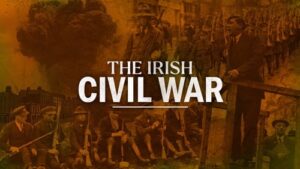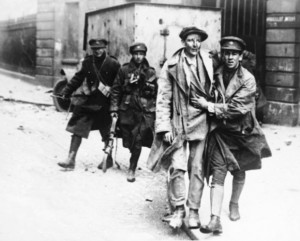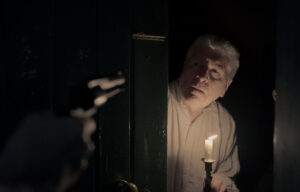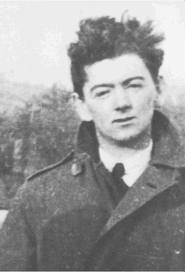TV documentary reviews: The Irish Civil War and Marú in Íarthar Chorcaí
 The Irish Civil War
The Irish Civil War
Directed by Ruan Mangan
Reviewer: Thomas Tormey
Airing on RTÉ One over the nights of 11,12,13 December and now available on the RTÉ Player, The Irish Civil War documentary series represents the national broadcaster’s latest contribution to the Decade of Centenaries. As such it follows on from numerous small documentaries as well as two other major series 1916 and The Irish Revolution. This is an interesting distribution of effort, for while the Civil War undoubtedly left a legacy that was both complex and contested, so too did the War of Independence.
And yet the Civil War, already covered in The Irish Revolution, was alone in being chosen for a separate treatment. Although we have had a couple of joint productions with the BBC featuring the erstwhile Tory Defence Minister and professional train traveller Michael Portillo on the period 1920-21 also.
Still, it is interesting that the main commissioned documentaries by RTÉ all reflect the commemorative practices of the state, and the statements of politicians. The latter have been noticeably much more vocal in recent weeks than they were in 2020 and 2021, bar the period when the crackpot notion of a state commemoration of the Royal Irish Constabulary gained a surprising amount of traction amongst the establishment.
The Irish Civil War documentary series was divided into three chronologically arranged episodes. Broadly speaking these were concerned with the Treaty split, the conventional phase of the Civil War (including the death of Michael Collins), and the guerrilla phase of the Civil War (including the establishment of the Free State). This was a reasonable break-down that followed long-established contours within the popular and academic historiography.

Furthermore, it is normal for treatments of the Civil War to include a lot of introductory material in order to fully illustrate the background to the conflict. In Calton Younger’s Ireland’s Civil War the shelling of the Four Courts commences on p. 323 of a 526-page text.[1] However, documentary series’ inclusion of a long goodbye concerning the legacy of the conflict felt excessive since it took up the final third of the final episode.
This piece could either have been an episode on its own or else greatly reduced. Also excessive was the recap at the start of each episode, which often jerkily included primary material rather than just an overview. Did we really need to hear Michael Collins’ ‘freedom to achieve freedom’ quote from the Treaty debates, which had been covered in the first episode, rendered at the start of the third?
One aspect of the series that has been criticised online was the use of historians as ‘talking heads’. This aspect of the production was not discussed by writer and director Ruan Magan in his otherwise informative piece on the RTÉ website last week.[2]
Although Magan did note how some of the choices around the use of a narrator and voice-over actors were in part driven by the lack of footage of the anti-Treatyites, particularly after they headed for the hills in August 1922. We can question this, for alternatives might have included the use of veteran interviews from later periods and dramatic reconstructions that were produced for various films and documentaries. In fairness, the ‘talking heads’, narrator, and voice actors, all combined to provide a watchable programme for the hard-pressed TV Licence holders of Ireland. As did the dynamic maps. This was surely a major purpose of the whole exercise. The Irish Times description of the series as resembling something from the Open University was overly harsh.[3]
In general, of course, this reviewer feels strongly that there should be more historians doing more of everything all the time. However, although Magan and his team made good use of many historians perhaps some of the editing choices were questionable. There seemed to be five historians who had an editorial input into the script.
These were Bill Kissane of the LSE, and the all-UCC team of script editors: John Borgonovo, John Crowley, Lindsey Earner-Byrne, and Dónal Ó Drisceoil. Perhaps these historians might be employed to regulate the editing of the documentary more tightly?
Specifically, they could have been used to ensure that the heads that make the final cut were exclusively talking about areas in which they have a high degree of expertise. Obviously, all of those interviewed have an exceptional level of historical understanding and would be welcome contributors even at the relatively specialised level of an undergraduate course at a major university.
But if individuals’ remarks are going to be broadcast into the living rooms of the nation, and preserved for posterity, it would be best if they were a published expert in the particular matter at hand rather than just, say, the ‘Civil War’, ‘the Irish Revolution’, or, indeed, ‘modern Irish history’ more broadly. The ‘talking heads’ formula works, but it is far preferable if historians are confined to talking to the public about their own research rather than other people’s books. The more general points could then be kept as the domain of the narrator or presenter. Although perhaps there would be a role here for consultants and/or editors to speak to camera.
Lastly, the programmes did feel as if they had a somewhat anti-Treatyite Republican slant. Magan mentioned in his piece on the RTÉ website that he is the grandson of the redoubtable Máire Comerford and her perspective, that of the doctrinaire republican militant, is perhaps more prominent that it should have been in the script read by Brendan Gleeson.
To be fair, there are numerous instances, across in all three episodes, of an anti-Treatyite value judgement, as voiced by Gleeson, being rolled back somewhat by the contribution of a historian, but this is a somewhat Irregular situation, in every sense. The misdeeds of the forces of the Provisional Government and later the Free State, who would after all have regarded themselves as the true ‘IRA’, are dealt with at great length, but the actions of the anti-Treatyites do not always receive the same degree of elucidation.
The coverage of the death of Michael Collins redresses this balance to some extent but it is noticeable that while there are often condemnations of Free State killings, no one questions the legitimacy of the West Cork IRA shooting at the head of the Provisional Government. In terms of naming the victims of lethal violence and/or detailing the circumstances in which they died, the samples that were covered in detail throughout the series are not proportionate to the overall figures for deaths provided in the final episode (700 pro-Treaty, 500 anti-Treaty, 300 civilians).
Although the fact that these figures are given is reflective of the series’ honest attempt to render the historical record in a balanced way.
The Irish Civil War is available on the RTÉ Player here.
Marú in Íarthar Chorcaí
Directed by Jerry O’Callaghan
Reviewer: John Dorney
 The new documentary Marú in Iarthar Chorcaí (‘Death in West Cork’) by Jerry O’Callaghan screened on TG4 on December 6 2022, deals with the events of April 1922 in West Cork in which 13 local Protestants were shot and killed, apparently in revenge for the shooting dead of IRA officer Michael O’Neill by a local loyalist.
The new documentary Marú in Iarthar Chorcaí (‘Death in West Cork’) by Jerry O’Callaghan screened on TG4 on December 6 2022, deals with the events of April 1922 in West Cork in which 13 local Protestants were shot and killed, apparently in revenge for the shooting dead of IRA officer Michael O’Neill by a local loyalist.
We have an article about these bloody events, which occurred in the period after the signing of Anglo-Irish Treaty, when most British forces had left the country, and the subsequent polemics over them here, from 2011.
The documentary features interviews with Canadian historian Peter Hart (just before the latter’s untimely death in 2010) who drew attention to the incident in his book ‘The IRA and its Enemies’ characterising it as a sectarian massacre; ‘these men were killed because they were Protestants’ he concluded and the Irish War of Independence was ‘a civil war between and within communities’. Moreover the southern Irish Protestant community he wrote, had suffered ‘what amounted to ethnic cleansing’.
In the documentary filmmaker Jerry O’Callaghan is apparently motivated not only to look into what happened in West Cork in 1922, but also by a desire to rebut Hart’s contentions that the War of Independence and the struggle for Irish independence were sectarian in nature. These objectives do not always run smoothly beside each other.
At times the documentary is side-tracked into discussing Hart’s reliability on other matters such as the famed ‘false surrender’ in the 1920 Kilmichael ambush, whether he called IRA officer Tom Barry a ‘political serial killer’ and so on.
This reviewer has always been of the (apparently minority) opinion that finding out what happened in West Cork then and why is more important than the credibility of the late Peter Hart.
Very detailed is evidence on each killing in April 1922 is presented in the documentary. These were foul, premeditated murders of unarmed and unsuspecting civilians, that much is clear. Several were lured to their deaths when called on for work reasons, others were shot in their homes in three nights of killings.
Historian John Borgonovo of University College Cork makes the, I think reasonable, suggestion that the killings were intended by the local IRA to send a message to the Protestant and/or loyalist community in West Cork to terrorise them in response to Michael O’Neill’s killing. He makes further point that while most targets in the three nights of killings in the Bandon Valley were either noted loyalists or suspected informers, relatives and co-workers were killed in their place when targets not found, which was very unusual by IRA standards, indicating collective punishment.

While local historian Meda Ryan and others have been keen to assert that those killed were targeted as informers, this makes little sense in the context of the post-Treaty environment, when almost all Crown Forces had left Co. Cork. Though quite a few of the victims may, as John Borgonovo and Andy Bielenberg make clear in the documentary, have helped Crown forces before the Truce of 1921, this does not explain why they suddenly came under attack in April 1922.
A complicating factor, however (unmentioned in the programme) may be the arrest and subsequent execution by the IRA of three British military intelligence officers in nearby Macroom, just before the outbreak of the killings in West Cork.
Prior to the documentary I hadn’t fully realised the geographical scope of shootings; almost throughout the IRA Cork 3 Brigade area, from Bandon in east to Balineen through to Dunmanway in the west and down to Clonakilty in south. Which begs question of how many IRA personnel were involved and what coordination there was at brigade level.
What was reaction of Tom Hales, the OC of 3 Cork Brigade, and Tom Barry, the commander of its Active Service Unit and Truce liaison officer in area? They were in Dublin at the time of the shootings, but did they, once they returned make any effort to investigate the incident to punish those responsible? Cork 3 Brigade leadership condemned the attacks and mounted guards to stop a repeat, but it was almost certainly their people who had carried them out.
Hart’s hyperbole about ‘ethnic cleansing’ and ‘unmixing of peoples’ obscures perhaps the true nature of the event. There was not, as O’Callaghan’s documentary is keen to point out a significant Protestant exodus from the area as a result, at least not in the long term. But the reality, though more nuanced, is bad enough. There were sensible comments by Thomas Eartls Fitzgerald to the effect that there was significant violence against southern Protestants in 1922 but not at scale of ethnic cleansing or mass displacement.
It was in the third part of the documentary, which went full on into disputing Hart’s narrative, where the film lost its way a little, departing from an investigation into events in West Cork and plunging instead into the ‘history wars’ and the idea that Irish history became distorted by a need to delegitimise republican violence in the late twentieth century.

Historian John Regan suggested that characterising republican violence in Ireland as sectarian in motivation ‘removes the ideological element’ including ‘anti-Imperialism’ from it. Which is a fair point and something Hart was indeed perhaps guilty of. However by same token, refusing to engage with existence of sectarianism in southern society in 1920s and subsequently obscures more than it illuminates.
Similarly I did not see what the view of Danny Morrison and others connecting the conduct of the IRA of the 1920s with that of 1970s and later did to illuminate events in West Cork in 1922.
I would strongly agree with Andy Bielenberg of UCC that the questions Hart raised regarding the southern Protestant community and its decline in numbers in the early twentieth century very important, even if many of his conclusions about them were often questionable.
In conclusion, Marú in Iarthar Chorcaí is well worth a watch, and includes much interesting research but I’d rather they had drilled deeper into events of April 1922 rather than gone down the road of refighting the Irish history wars. Watch it back on TG4 player here.
If you enjoy the Irish Story and wish to support our work, please consider contributing at our Patreon page here.
Notes
[1] Calton Younger, Ireland’s Civil War (2nd ed., London, 1978).
[2] https://www.rte.ie/history/irish-free-state/2022/1128/1338814-the-irish-civil-war-the-making-of-the-documentary/
[3] https://www.irishtimes.com/culture/tv-radio/2022/12/13/the-irish-civil-war-part-3-by-the-final-credits-even-narrator-brendan-gleeson-sounds-ready-to-check-out/.